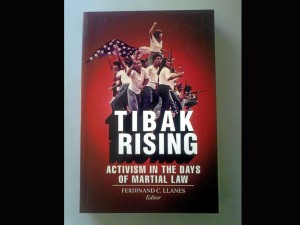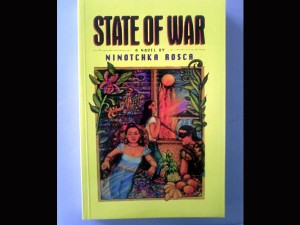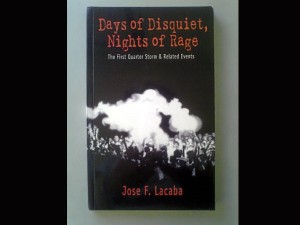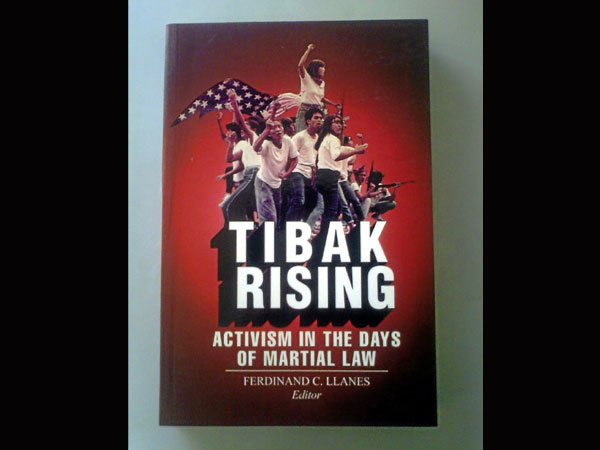 Like the pages of an old diary, the years gone by since martial law come in different conditions. Some are dog-eared from constant scrutiny. Others are ripped from forceful amnesia, while others are brittle from having been dried after an encounter with water, most probably the business end of a water cannon. The handwriting can be smeared by tears and entire pages can be blank or gone missing.
Like the pages of an old diary, the years gone by since martial law come in different conditions. Some are dog-eared from constant scrutiny. Others are ripped from forceful amnesia, while others are brittle from having been dried after an encounter with water, most probably the business end of a water cannon. The handwriting can be smeared by tears and entire pages can be blank or gone missing.
The 40th anniversary of proclamation 1081 is the perfect opportunity to leaf through the many books that have been written about this dark and historic period.
After the Marcos regime was dismantled in 1986, the books have come out one by one, each revealing its own piece of the martial law puzzle. Some are personal recollections of incarceration while others are tales of life lived constantly on the run. Some books unveiled the secrets and whereabouts of political leaders while other recalled details of volunteerism and offered glimpses of those rare bright spots in a blighted landscape. All of them are part of the big story of martial law. And now is the best time to tell it.
 As it stands, Filipino schoolchildren learn of martial law for only one quarter in a year, the fourth quarter of freshman year (see sidebar). But beyond required reading, Filipinos need to read these books because they need to remember-and ultimately never forget. Martial law was too terrible a time and the damage it left far too profound to be relegated to the past.
As it stands, Filipino schoolchildren learn of martial law for only one quarter in a year, the fourth quarter of freshman year (see sidebar). But beyond required reading, Filipinos need to read these books because they need to remember-and ultimately never forget. Martial law was too terrible a time and the damage it left far too profound to be relegated to the past.
“Time and the Marcoses have embarked on the Great Forgetting,” writes Conrado de Quiros in his introduction to “Not On Our Watch.” “It is things like this that should jolt us into a Great Remembering.”
Here then in alphabetical order are the books about martial law to help us remember.
 “Days of Disquiet, Nights of Rage: The First Quarter Storm & Related Events” by Jose F. Lacaba (Anvil Publishing, Inc.): Originally published in 1982, before the actual end of the Marcos era, this gripping, first-person account of the political awakening of the Filipino youth is considered by most to be the definitive chronicle of latent student and labor activism in the Philippine setting. It is also the best place to begin reading up about martial law as the wave of protests, so poetically and powerfully reported by Lacaba, eventually runs into the stormy shoals of what would later become the Marcos dictatorship. Here are the seeds that bloomed into steely demonstrations on the street for some, and total revolutionary resistance by others. Read this book to see where all the courage came from and why it all began.
“Days of Disquiet, Nights of Rage: The First Quarter Storm & Related Events” by Jose F. Lacaba (Anvil Publishing, Inc.): Originally published in 1982, before the actual end of the Marcos era, this gripping, first-person account of the political awakening of the Filipino youth is considered by most to be the definitive chronicle of latent student and labor activism in the Philippine setting. It is also the best place to begin reading up about martial law as the wave of protests, so poetically and powerfully reported by Lacaba, eventually runs into the stormy shoals of what would later become the Marcos dictatorship. Here are the seeds that bloomed into steely demonstrations on the street for some, and total revolutionary resistance by others. Read this book to see where all the courage came from and why it all began.
“Killing Time in a Warm Place” by Jose Y. Dalisay, Jr. (Anvil Publishing, Inc.): This textured, award-winning roman a clef is a lovely fictionalization of Dalisay’s own experiences as a student activist and writer during the martial law years. At the beginning, Noel Ilustre Bulaong could be any of us, until his quiet life in bucolic Kangleong,is both transformed and shattered by the all-encompassing presence of Ferdinand Marcos. Bulaong becomes an activist and witnesses first hand, through arrest and detention, the shadowy hold of the Marcos era. Perhaps the most haunting part of “Killing Time” is how everyone ended up, and the deaths-both interior and exterior-that they experience. A vivid tale of those dangerous years, this is Dalisay at his best.
“Martial Law Babies: A Graphic Novel” by Arnold Arre (Tala Studios/Nautilus Comics): The very phrase “martial law baby” has a hint of whimsy and loss in it, and Arre explores the young lives of the children who grew up knowing only Marcos and his New Society through his distinctive black-and-white panel work. Then he launches into a study of what happened to these troubled and hopeful children as they grow into adulthood and face life way beyond the martial law years. Funny and poignant, “Martial Law Babies” is a comic-book survey of a lost generation and its efforts to find its way home from the talented author of “The Mythology Class.”
“Martial Law in the Philippines: My Story” by Aquilino Q. Pimentel, Jr. (Lorraine Pimentel Borghijs): This hefty tome from a respected senator covers 15 years of difficult life after proclamation 1081 from the point of view of a man named “Nene” who was never afraid to stand up for his beliefs. Chock full of small details as well as big-picture perspective, this book is at its strongest when recalling how Pimentel personally dealt with the Marcosian authorities at every point in his political life.
“Not on our Watch: Martial Law Really Happened. We Were There” edited by Jo-Ann Q. Maglipon (Publications Group, LEADS-CEGP 6972, Inc.): Aside from student activists, student journalists really stepped up to the challenge of recording unblemished history in the tumultuous years leading up to 1972. This anthology of 14 essays from the members of the College Editors Guild of the Philippines and the group they formed (the Leaders for a Demoractic Society) tells 14 different stories of life as both young journalist and activist at a time when being either was trouble. Passionate and wry, serious and smart, the contributions are complimented by Conrado de Quiros’ fierce introduction and form a memorable mosaic of personal martial law vignettes.
“Si Jhun-Jhun, Noong Bago Ideklara ang Batas Militar” by Augie Rivera, illustrated by Brian Vallesteros (Adarna House): Have you ever wondered how to introduce the difficult circumstances of martial law to young children who had never experienced it? This innovative and emotionally bracing children’s book does just that. Jhun-jhun wonders where his Kuya Jaime has been going off to lately, and discovers a frightening and violent set of answers. Curiosity and sadness permeate this storybook, which is perhaps the best way to tell our young ones about how life really changed in 1972.
“State of War: A Novel” by Ninotchka Rosca (Anvil Publishing, Inc.): Former political prisoner and multi-awarded writer Rosca may not have uttered the name “Marcos” once in her 1988 novel, but a cursory evaluation of the man dubbed only as “The Commander,” and readers immediately know who he is. “State of War” begins with three friends-Adrian, Anna and Eliza-travel to an island festival only to get caught up in potentially deadly intrigues as someone hatches a plot to kill The Commander before he gets too powerful. Many tangents connect the events of the novel to the Philippines’ long-past and recent history, but even without the political symbolism, the novel remains a gripping read.
“Subversive Lives: A Family Memoir of the Marcos Years” by Susan F. Quimpo, Nathan Gilbert Quimpo and others (Anvil Publishing, Inc.): Many people can truthfully say that their family was affected by martial law, but few have as involved and as harrowing a family experience as that of the Quimpos. This oral history retells how nine Quimpo siblings did their part to further the resistance against martial law, leading to loss and betrayal as the fight went on. By telling their family’s tale, the Quimpos also tell the story of the Communist Party of the Philippines and the inner conflicts that divided its own members. A book about struggle big and small and families of different sorts, told from the viewpoint of a family that paid a terrible price for what the book calls an unfinished revolution.
“Tibak Rising: Activism in the Days of Martial Law” edited by Ferdinand C. Llanes (Anvil Publishing, Inc.): The very origin of the word “tibak” (from the word “aktibista”) says it all. This book delivers a most intimate collection of individual stories about the struggle against martial law, boasting of contributors ranging from Gilda Cordero-Fernando and Edicio de la Torre to Joel Saracho and Joel Rocamora. The book is about a way of life that found its greatest purpose as well as its more challenging incarnation during the dark period from 1972 to 1986. Here is a fantastic gathering of those recollections, full of change, friendship and ultimately struggle on all levels.
“U.G. An Underground Tale: The Journey of Edgar Jopson and the First Quarter Storm Generation” by Benjamin Pimentel, Jr. (Anvil Publishing, Inc.): One of the most fascinating and, in turn, tragic personalities connected with martial law was Edgar “Edjop” Jopson. The Ateneo student council leader devoted himself to the nascent student activist movement just in time to face off (at one point literally) with Ferdinand Marcos. But Jopson was serious about his struggle, relocating with his cadre constantly to escape military pursuit. His later death at the hands of the military makes this story of heroism bright and sharp at the same time, delivered with efficient and measured prose by columnist Pimentel. It’s a true story of inspiration and sacrifice you won’t forget. •
For further reading on martial law please check out the following: “The Jupiter Effect: A Novel” by Katrina P. Tuvera; “Inside the Palace: The Rise and Fall of Ferdinand and Imelda Marcos” by Beth Day Romulo; “Breaking Through: The Struggle Within the CPP” by Joel M. Rocamora; “Down from the Hill: Ateneo de Manila in the First Ten Years of Martial Law” by Cristina Jayme T. Montiel and Susan Evangelista; “Mondo Marcos: Writings on Martial Law and the Marcos Babies,” edited by Frank Cimatu and Roland B. Tolentino; “More Assassinations and Conspiracies” by Manuel F. Martinez; “Armando J. Malay, A Guardian of Memory: The Life and Times of a Filipino Journalist and Activist” by Marites N. Sison and Yvonne T. Chua; “Dateline Manila” by the Foreign Correspondents Association of the Philippines; “Living and Dying: In Memory of 11 Ateneo de Manila Martial Law Activists” by Geraldine C. Villaluz; “Dead Aim: How Marcos Ambushed Philippine Democracy” by Conrado de Quiros, and “Mass: A Novel” by F. Sionil Jose.
THE GREAT REMEMBERING: These books are available at a perfect time to remember martial law










































